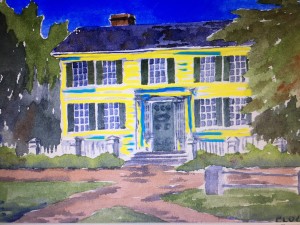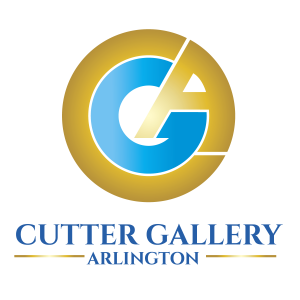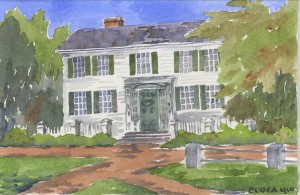MISSION STATEMENT:
The Cutter Gallery Arlington is dedicated to the promotion and support of aspiring and established local artists by providing exhibition space, support, and encouragement to bring creative arts to life.
Cutter Gallery Arlington was the inspiration of Bernice Nigro.
In 1980, The John Mirak Foundation donated the historic Jefferson Cutter House to the Town of Arlington. The Town created a new location for the building in the Whittemore Park right in the town center. The town created a public conference room in the lower rear section of the building, complete with kitchen space and restrooms.
Bernice sought to take advantage of the newly created conference room at the Jefferson Cutter House for a public art space. The room was a perfect location to display local art to the community. With that, Cutter Gallery Arlington was born. Bernice promoted the Gallery as a place where aspiring and established local artists could exhibit and sell their work. In the 24 years since, the Gallery has helped over 200 local artists by providing exhibition space and support.
In 1982, Nancy Flynn assumed the role of Director of the Cutter Gallery Arlington. Under her watchful eye, the Gallery increased its reputation as a place that promotes and supports local arts to the Arlington community.
COVID-19 Gallery Guidelines:
Social Distancing
Each museum must monitor visitor entries and exits and limit occupancy for each building open to the public at all times to:
- 40% of the museum’s maximum permitted occupancy as documented in its occupancy permit on record with the municipal building department or other municipal record holder
- Facilities for which no permitted occupancy limitation is on record may allow 8 persons (including staff) per 1,000 square feet of accessible indoor or outdoor space
- In any case, no enclosed space within the facility may exceed occupancy of 8 persons per 1,000 square feet
- All occupant counts and calculations shall include customers, staff, and other workers
- Ensure separation of 6 feet or more between individuals where possible:
- Close or reconfigure worker common spaces and high density areas where workers are likely to congregate (e.g., break rooms, eating areas) to allow social distancing
- Physical partitions must separate workstations that cannot be spaced out (partitions must be at least 6 feet in height)
- Install physical barriers for ticket counters, checkout stations, etc. where possible
- Install visual social distancing markers to encourage visitors to remain 6 feet apart (e.g., lines outside of the museum if applicable, lines to make payments, lines to use the restroom)
- Mark exhibit rooms and hallways to indicate 6 feet separation
Post clearly visible signage regarding the need to maintain 6 feet of social distancing and not to enter a room until that distancing can be maintained
Establish directional pathways to manage visitor flow for foot traffic, if possible, to minimize contact (e.g., one-way entrance and exit to rooms / exhibits, one-way pathways). Post clearly visible signage regarding these policies
Stagger lunch and break times, regulating max number of people in one place and ensuring at least 6 feet of physical distancing
Require face coverings for all workers and visitors, except where unsafe due to medical condition or disability
Encourage the use of electronic versions of guide materials (such as brochures and gallery guides) where possible. All physical guide materials (such as paper brochures, gallery guides, and audio guides) must be discarded or sanitized between use. Any self-serve racks must be removed, and all materials must be handed out individually
Group Size Limitations for Guided Tours
Each tour operator using a bus or other vehicle (such as a trolley, harbor cruise vessel, or duck boat) must limit occupancy at all times to 50% of the tour, vehicle or vessel’s maximum permitted occupancy as documented in its occupancy permit on record with the relevant municipal record holder
Occupancy limitations for boat tours using vessels with open deck space that can be used to accommodate passengers shall be determined in accordance with the formula used to set charter boat occupancy limits, outlined in the Workplace Safety and Reopening Standards for For-Hire and Charter Vessels
Tours of spaces for which no permitted occupancy limitation is on record must limit occupancy based on the Indoor and Outdoor Event guidance on the Reopening Website
All occupant counts and calculations shall include customers and workers
Groups of passengers should be separated on the vehicle by empty seats. If that is not possible, vehicles should stagger open rows
Tour operators must limit group size in walking tours to groups of no more than 10 persons
Guides and guests should maintain 6 feet of distance and wear face coverings

